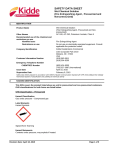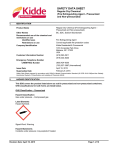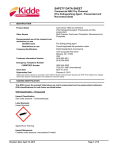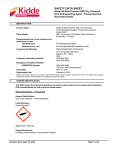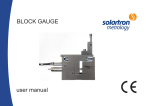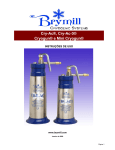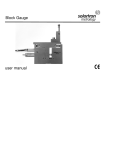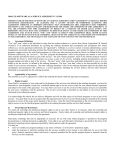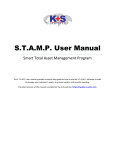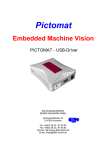Download HAPPY HOLIDAYS!!
Transcript
Volume 8, 11-2013 HAPPY HOLIDAYS!! Hierarchy of Controls Enjoy and Be SAFE!! IBC News U OF R- ENV. HEALTH & SAFETY The laboratory environment can be a hazardous place to work. Laboratory workers are exposed to numerous potential hazards including chemical, biological, physical and radioactive hazards, as well as musculoskeletal stresses. Laboratory safety is governed by numerous local, state and federal regulations. Over the years, OSHA has promulgated rules and published guidance to make laboratories increasingly safe for personnel. The following discussion of the Hierarchy of Controls has been excerpted from OSHA’s Laboratory Safety Guidance. https:// www.osha.gov/Publications/laboratory/ OSHA3404laboratory-safety-guidance.pdf Occupational safety and health professionals use a framework called the “hierarchy of controls” to select ways of dealing with workplace hazards. The hierarchy of controls prioritizes intervention strategies based on the premise that the best way to control a hazard is to systematically remove it from the workplace, rather than relying on workers to reduce their exposure. The types of measures that may be used to protect laboratory workers, prioritized from the most effective to least effective, are: • engineering controls; • administrative controls; • work practices; and • personal protective equipment (PPE) Most employers use a combination of control methods. Employers must evaluate their particular workplace to develop a plan for protecting their workers that may combine both immediate actions as well as longer term solutions. A description of each type of control for nonproduction laboratories follows. Engineering controls are those that involve making changes to the work environment to reduce work related hazards. These types of controls are preferred over all others because they make permanent changes that reduce exposure to hazards and do not rely on worker behavior. By reducing a hazard in the workplace, engineering controls can be the most costeffective solutions for employers to implement. Examples include: • Chemical Fume Hoods; and • Biological Safety Cabinets (BSCs). Administrative controls are those that modify workers’ work schedules and tasks in ways that minimize their exposure to workplace hazards. Examples include: Examples include: · No mouth pipetting; · Chemical substitution where feasible (e.g., selecting a less hazardous chemical for a specific procedure). Personal Protective Equipment (PPE) is protective gear needed to keep workers safe while performing their jobs. Examples of PPE include respirators (for example, N95), face shields, goggles and disposable gloves. While engineering and administrative controls and proper work practices are considered to be more effective in minimizing exposure to many workplace hazards, the use of PPE is also very important in laboratory settings. It is important that PPE be: • Selected based upon the hazard to the worker; • Properly fitted and in some cases periodically refitted (e.g., respirators); • Conscientiously and properly worn; • Regularly maintained and replaced in accord with the manufacturer’s specifications; • Properly removed and disposed of to avoid contamination of self, others or the environment; and • If reusable, properly removed, cleaned, disinfected and stored. HIERARCHY OF CONTROLS Elimination/Substitution Most Effective Requires a physical change to the workplace Requires worker or employer to do something Least Effective Requires worker to wear something Mary Jo’s Safety Corner “CRYOGENIC LIQUIDS” Working with cryogenic liquids, and liquid nitrogen, in particular, requires that strict rules to be followed. These rules are designed to prevent or reduce two major hazards: anoxia and cryogenic burns caused by contact with liquid nitrogen. Anoxia Oxygen is an essential element in maintaining life. Therefore, it is necessary to assure that the air one works in has an adequate level of oxygen. Anoxia, caused by insufficient levels of oxygen, is a real risk in all areas of cryogenic activities and applications, e.g. bio-repositories and cryogenic laboratories. The response of an organism to under-oxygenation in the air is highly variable from one individual to the next. In addition, human sensory organs are incapable of detecting the dangers of low oxygen levels in the air. The Cause of anoxia: a lack of oxygen in the air The air we breathe is made up of 21% oxygen, 79% nitrogen and very small amounts of rare gases. At normal atmospheric pressure, liquid nitrogen will vaporize above -196oC. A decrease in oxygen levels, caused by an increase in the nitrogen levels in the air, can easily occur in any cryogenic area or room during routine activities and procedures, e.g. loading and unloading samples in cryogenic freezers and using vessels that store liquid. In fact, the manipulation of liquid nitrogen will result in its vaporization and at normal atmospheric pressure 1 liter of liquid nitrogen will produce 691 liters of gas when warmed up to an ambient room temperature. Detecting under – oxygenation WARNING! Most of the gases used in cryogenic applications are undetectable by humans. Best method and practices for measuring oxygen levels: A continuous method of measurement is necessary for areas and rooms where the concentration of oxygen may be dangerously altered during routine activities and procedures, e.g. loading and unloading samples in cryogenic freezers and using vessels that store liquid nitrogen. A non-continuous method of measurement may be used if the time-lapse between two readings and analyses of the oxygen levels in the air are realized in a short enough time- frame to signal and alarm is the oxygen levels are too low. Preventing Anoxia: Some precautions to take A small amount of nitrogen gas in liquid phase has the potential to create a much larger volume in an atmospheric phase. Consequently, a liquid nitrogen leak or spill in a confined or inadequately ventilated space can very quickly result in a dangerously low level of atmospheric oxygen. To eliminate this risk, the user needs to make sure that where the nitrogen liquid or gas is present, both in the work and storage spaces, that there is sufficient ventilation and if needed permanent or portable oxygen detectors and for emergency situations portable individual respirators should be made easily accessible. SAFETY ACCESSORIES Handling products stored in liquid nitrogen or working with cryogenic fluids create an extremely high risk factor for cryogenic burns. These burns can have serious consequences, especially when the eyes or face are involved. Therefore, it is imperative to reduce the risks of burns from splashing or contact with liquid nitrogen. Recommendations when working with liquid nitrogen Protection of hands by using correctly adapted cryogenic protective gloves or related equipment. Protection of the face and eyes by using correctly adapted cryogenic protective glasses, visor, or related equipment. Protection of face and eyes by using correctly adapted cryogenic protective glasses. Make sure that all cryogenic work and storage rooms are correctly ventilated and have the appropriate oxygen level detectors and alarms and Anoxia safety masks. Read the User’s Manual Extreme Low temperature Do not touch directly, at any time. Items that have been in contact with liquid nitrogen. Safety in the Workplace Wear safety glasses or a visor, gloves and protective accessories (e.g. cryo apron and gaiters). A portable oxygen detector is also recommended for detecting dangerous levels of: 1. Carbon monoxide 2. Hydrogen sulphide, oxygen 3. Nitrogen Oxide 4. Sulphur Dioxyde CAUTION!!! Prescription eye glasses are not protective. The unprotected hand should never manipulate any items that have been in contact with liquid or gaseous nitrogen. The hands, even when wearing the cryo-gloves, should never be submerged in a cryogenic liquid. For guidance in choosing a low oxygen sensor/alarm Contact the EHS—Occupational Safety Unit at 275-3241





